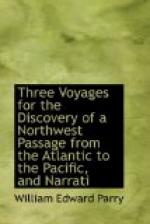disposed in large and regular stitches. Before
the passages already described, others were now added,
from ten to fifteen feet in length, and from four
to five feet high, neatly constructed of large flat
slabs of ice, cemented together by snow and water.
Some huts also were entirely built of this material,
of a rude circular or octangular form, and roofed
with skins like the others. The light and transparent
effect within these singular habitations gave one the
idea of being in a house of ground glass, and their
newness made them look clean, comfortable, and wholesome.
Not so the more substantial bone huts, which, from
their extreme closeness and accumulated filth, emitted
an almost insupportable stench, to which an abundant
supply of raw and half-putrid walrus’ flesh
in no small degree contributed. The passages
to these are so low as to make it necessary to crawl
on the hands and knees to enter them; and the floors
of the apartments were in some places so slippery,
that we could with difficulty pass and repass, without
the risk of continually falling among the filth with
which they were covered. These were the dirtiest,
because the most durable, of any Esquimaux habitations
we had yet seen; and it may be supposed they did not
much improve during the winter. Some bitches with
young were very carefully and conveniently lodged
in small square kennels, made of four upright slabs
of ice covered with a fifth, and having a small hole
as a door in one of the sides. The canoes were
also laid upon two slabs of this kind, like tall tombstones
standing erect; and a quantity of spare slabs lying
in different places, gave the ground an appearance
somewhat resembling that of a statuary’s yard.
Large stores of walrus’ and seals’ flesh,
principally the former, were deposited under heaps
of stones all about the beach, and, as we afterward
found, in various other parts of the island, which
showed that they had made some provision for the winter,
though, with their enormous consumption of food, it
proved a very inadequate one.
Leaving the Fury at seven A.M. on the 26th, and being
favoured by a fresh easterly breeze, we soon cleared
the southwest point of Igloolik; and, having passed
the little island of Oogli=aghioo, immediately
perceived to the W.N.W. of us a group of islands, so
exactly answering the description of Coxe’s
Group, both in character and situation, as to leave
no doubt of our being exactly in Captain Lyon’s
former track. Being still favoured by the wind
and by the total absence of fixed ice, we reached
the islands at eleven A.M., and, after sailing a mile
or two among them, came at once in sight of two bluffs,
forming the passage pointed out by Toolemak, and then
supposed to be called Khemig. The land
to the north, called by the Esquimaux Khiadlaghioo,
was now found to be, as we had before conjectured,
the southern shore of Richards’s Bay. The
land on our left or to the southward proved an island,
five miles and a quarter in length, of the same bold




